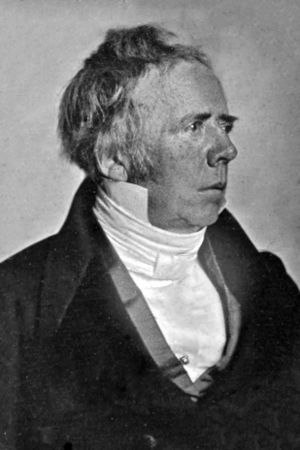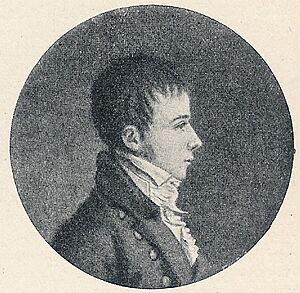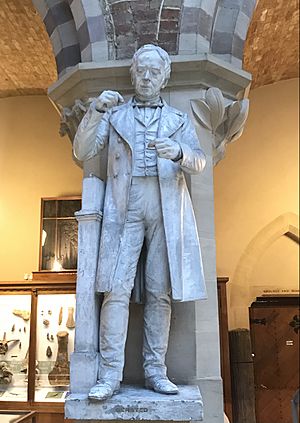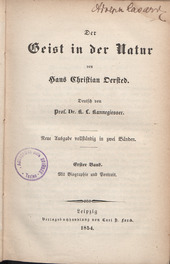Hans Christian Ørsted facts for kids
Quick facts for kids
Hans Christian Ørsted
|
|
|---|---|
 |
|
| Born | 14 August 1777 Rudkøbing, Denmark-Norway
|
| Died | 9 March 1851 (aged 73) Copenhagen, Denmark
|
| Nationality | Danish |
| Alma mater | University of Copenhagen (PhD, 1799) |
| Known for | Discovery of electromagnetism and Aluminium Ørsted's law Thought experiment |
| Awards | Copley Medal (1820) |
| Scientific career | |
| Fields | Physics, chemistry, aesthetics |
| Institutions | University of Copenhagen, Technical University of Denmark (Founder and Principal) |
| Influences | Immanuel Kant |
| Signature | |
 |
|
Hans Christian Ørsted (born August 14, 1777 – died March 9, 1851) was a famous Danish scientist. He was a physicist and chemist. Ørsted made a huge discovery: he found that electric currents create magnetic fields. This was the first time anyone showed a link between electricity and magnetism. Because of his work, a scientific law and a unit of measurement are named after him.
Ørsted was a key figure during the Danish Golden Age. He was a good friend of the famous storyteller Hans Christian Andersen. His brother, Anders Sandøe Ørsted, even became the Prime Minister of Denmark.
Contents
Early Life and Learning
Hans Christian Ørsted was born in a town called Rudkøbing in 1777. When he was young, he helped his father at the local pharmacy. This sparked his interest in science. He and his brother, Anders, mostly studied at home.
In 1793, they both went to Copenhagen. They passed their entrance exams for the University of Copenhagen. Both brothers were excellent students. By 1796, Ørsted had won awards for his writings. These papers were about both physics and aesthetics, which is the study of beauty and art. In 1799, he earned his PhD. His main paper was based on the ideas of the philosopher Immanuel Kant.
In 1800, Alessandro Volta invented the voltaic pile, an early battery. This invention made Ørsted want to learn more about electricity. He started doing his own electrical experiments. In 1801, Ørsted received money to travel around Europe for three years. He visited important science centers, like those in Berlin and Paris.
In Germany, Ørsted met a physicist named Johann Wilhelm Ritter. Ritter believed that electricity and magnetism were connected. This idea made sense to Ørsted. He believed that all parts of nature were connected, a bit like Kant's ideas. Talking with Ritter made Ørsted focus on physics. In 1806, he became a professor at the University of Copenhagen. He kept studying electric currents and sound. Thanks to him, the university created strong physics and chemistry programs. They also built new laboratories.
Ørsted was the first person to clearly describe and name the "thought experiment." This is when you imagine an experiment in your mind to explore an idea. He used this idea around 1812.
Discovering Electromagnetism
In 1820, Ørsted made his most famous discovery. He found that an electric current could move a compass needle. This showed a direct link between electricity and magnetism. This was not an accident during a lecture, as some stories say. Ørsted had been looking for this connection since 1818. He was often confused by his early results.
At first, he thought magnetic effects spread out from all sides of a wire. He thought it was like how light and heat spread. Three months later, he did more intense research. He then published his findings. He showed that an electric current creates a circular magnetic field around the wire. For this amazing discovery, the Royal Society of London gave Ørsted the Copley Medal in 1820. The French Academy also gave him 3,000 francs.
Ørsted's discovery led to a lot of new research. Scientists around the world started studying electrodynamics. For example, French physicist André-Marie Ampère developed a math formula. It described the magnetic forces between wires carrying current. Ørsted's work was a big step. It helped scientists understand that different types of energy are connected.
The "Ørsted effect" also led to a communication revolution. It was used to create the electric telegraph. This invention allowed messages to be sent over long distances using electricity. The idea for such a telegraph came quickly after Ørsted's discovery. But it took almost 20 years for it to become a real, working technology.
Later Years and Achievements
Ørsted became a member of many important science groups. He joined the Royal Swedish Academy of Sciences in 1822. He also became a member of the American Philosophical Society in 1829.
In 1824, he started a group called Selskabet for Naturlærens Udbredelse (SNU). This group helped share scientific knowledge with more people. He also helped create groups that later became the Danish Meteorological Institute. This institute studies weather. He also helped create the Danish Patent and Trademark Office. In 1829, Ørsted founded a new college. It was called Den Polytekniske Læreanstalt. Today, it is known as the Technical University of Denmark (DTU).
In 1825, Ørsted made another important discovery in chemistry. He was the first to produce aluminium in a nearly pure form. In 1808, Humphry Davy had guessed that this metal existed. He even named it "alumium." But Davy could not get it in a pure form. Ørsted was able to separate the element. He did this by using a process called reduction on aluminium chloride. The aluminium he got still had some impurities. But he is still given credit for discovering the metal. His work was later improved by Friedrich Wöhler. Wöhler got pure aluminium powder in 1827. He then made solid balls of molten aluminium in 1845. Wöhler is known for being the first to get the metal in a truly pure form.
Ørsted passed away in Copenhagen in 1851. He was 73 years old. He was buried in the Assistens Cemetery.
Ørsted's Legacy
The unit of magnetic induction in the centimetre-gram-second (CGS) system is called the "oersted." It is named after him because of his work in electromagnetism.
Places Named After Ørsted
Many places are named after Hans Christian Ørsted. The Ørsted Park in Copenhagen was named after him and his brother in 1879. Streets like H.C. Ørsteds Vej in Frederiksberg are also named in his honor.
The buildings for the Chemistry and Mathematical Sciences departments at the University of Copenhagen are called the H.C. Ørsted Institute. A student dorm in Odense is also named H. C. Ørsted Kollegiet.
The first Danish satellite, launched in 1999, was named "Ørsted."
Monuments and Awards
A statue of Hans Christian Ørsted was placed in Ørsted Park in 1880. A special plaque is above the gate of the building where he lived and worked. His picture was also on the 100 Danish krone banknote from 1950 to 1970.
In 1885, another statue of Ørsted was put in the Oxford University Museum of Natural History.
Two important medals are given out in Ørsted's name. The Oersted Medal is for great contributions to teaching physics in America. The H. C. Ørsted Medal is for Danish scientists. Both are awarded by science societies.
Writings
Ørsted was also a writer and a poet. His poetry series Luftskibet ("The Airship") was inspired by hot air balloon flights. Before he died, he put together a collection of articles. It was called Aanden i Naturen ("The Soul in Nature"). This book shares Ørsted's ideas about life and many other topics.
- (in fr) Ansicht der chemischen Naturgesetze, durch die neueren Entdeckungen gewonnen. Paris: Jean Gabriel Dentu. 1813. https://gutenberg.beic.it/webclient/DeliveryManager?pid=12236149.
- (in de) Aanden i Naturen. 1. Leipzig: Lorck. 1854. https://gutenberg.beic.it/webclient/DeliveryManager?pid=682714.
- (in de) Aanden i Naturen. 2. Leipzig: Lorck. 1854. https://gutenberg.beic.it/webclient/DeliveryManager?pid=683267.
- Recherches sur l'identité des forces chimiques et électriques (French; translated from German by Mr. Marcel de Serres). Paris : J.G. Dentu, imprimeur-libraire. 1813.
Images for kids
See also
 In Spanish: Hans Christian Ørsted para niños
In Spanish: Hans Christian Ørsted para niños
- History of aluminium
- James Clerk Maxwell
- Michael Faraday
- Gian Domenico Romagnosi, who observed an electrostatic attraction of a compass needle










